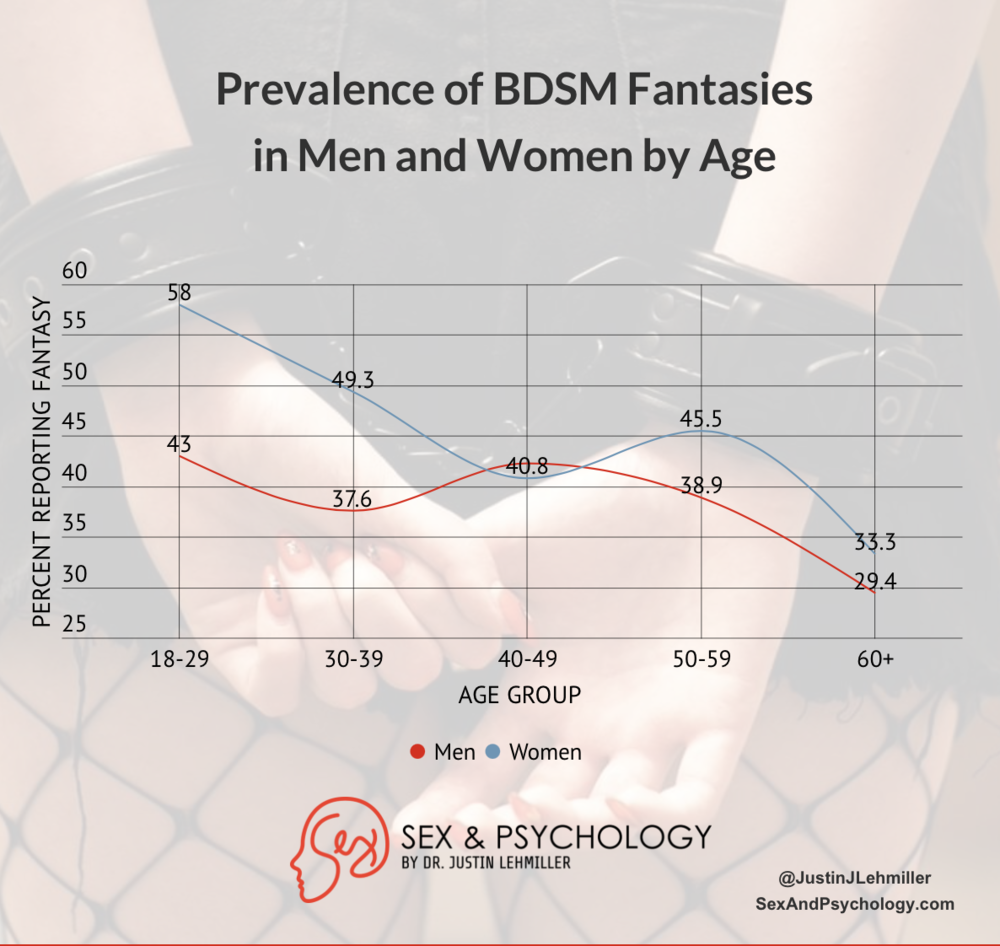The Way Our Sex Fantasies Change with Age Might Reflect Changes in Personality
April 14, 2021 by Justin Lehmiller
People tend to think of personality as a relatively stable characteristic of the self that doesn’t usually change much over the course of our lives. However, this way of thinking isn’t supported by the research. In fact, there appear to be some pretty sizeable personality shifts that take place over the life cycle.
I recently came across a study that explored how men’s and women’s personalities change with age and I found the results to be fascinating. However, as I was reviewing the data, I couldn’t help but think about how the shifts in personality we’re seeing could potentially explain something I see in my own research on sexual fantasies, given that our fantasies appear to change with age, too.
It may be that the way our personalities evolve over time leads our fantasies to evolve along with them.
For example, consider fantasies about practicing non-monogamy, such as being polyamorous, being in an open relationship, swinging, or cuckolding. According to the data that I present in my book Tell Me What You Want (which involved a survey of 4,175 Americans’ sexual fantasies), non-monogamy fantasies tend to increase with age. However, the association is one that would best be described as curvilinear rather than linear. In other words, these fantasies rise to a point and then decrease to some extent after that.
You can see a visual depiction of these data in the figure below. This figure reflects the percentage of men and women who reported that non-monogamy is part of their favorite sexual fantasy of all time, with the data separated by age group. The number of people reporting this fantasy rises through the 40s, and then declines somewhat after that, although it never drops back down to where it was for the youngest age group. Note that the pattern is similar for men and women, although men report more non-monogamy fantasies across age groups.
When I look at how non-monogamy fantasies are related to personality traits, I see that people who are high in extraversion (meaning those who are more sociable and outgoing), high in openness to experience (meaning those who are more willing to try new and different things), and those who are low in neuroticism (meaning those who deal with stress better and have more emotional stability) report more non-monogamy fantasies of almost every type.
However, what’s really interesting about the new paper on personality and age that I mentioned above is that extraversion and openness tend to increase with age, whereas neuroticism tends to decrease. So one way to look at why non-monogamy fantasies tend to increase with age is that this might reflect an underlying shift in certain personality traits that may predispose people to exploring this fantasy.
To consider another example, let’s look at how BDSM fantasies are related to age. What you can see in the figure below is the percentage of men and women who said that BDSM is part of their favorite sexual fantasy of all time, separately by age group. Here, the pattern is actually quite different from the non-monogamy fantasies. Again, you don’t see a perfectly linear association, but you do see a general trend for these fantasies to decline with age. They’re most popular among younger adults and least popular among older adults—and, in general, more common among women than men.

Now when I look at how BDSM fantasies are related to personality, I see that these fantasies are linked to higher levels of neuroticism (meaning those who do not deal as well with stress and have more emotional instability), lower levels of agreeableness (meaning those who have less care and concern for others), and lower levels of conscientiousness (meaning those who are less organized and detail-oriented). [Sidebar: I realize this pattern is quite different from other research on BDSM and personality—however, keep in mind that other studies examined actual BDSM practitioners, not the fantasy of BDSM in a general sample. Thus, the personality traits of people who are doing BDSM in real life seem to be rather distinct from the personality traits of people who simply have BDSM fantasies, most of whom have never acted on them. Translation: we’re talking about very different groups of people, so I wouldn’t generalize the personality correlates of BDSM fantasies to those who practice kink/BDSM in real life.]
So how do those personality traits change with age? As people get older, neuroticism tends to go down, whereas agreeableness and conscientiousness tend to go up. Again, this pattern fits with the idea that age-related changes in BDSM sexual fantasies may reflect broader age-related changes in personality, at least to some extent (after all, BDSM fantasies don’t disappear or anything like that, so personality is just one small part of the story—gender, of course, is another part of it, as you can see in the figures above).
I see similar trends when I look at other types of sexual fantasies (e.g., multi-partner sex), which suggests that there might very well be something to this idea. I plan to write this up soon in the form of an academic paper and do a more thorough exploration of these ideas—so keep an eye out for that!
However, let me caution that our fantasies are complex and that personality is just one of many factors linked to sexual fantasy content. Thus, two people could have very different combinations of personality traits, yet have the same themes in their fantasies. For example, two people could say that their favorite fantasy is about BDSM, but those fantasies could play out in extremely different ways (e.g., sadistic vs. masochistic, dominant vs. submissive, gentle vs. rough) that reflect very different personality profiles.
Our fantasies are highly individualized, which means that when I say that a given personality trait is linked to higher odds of having a given fantasy, this doesn’t necessarily mean that everyone with that personality trait has that fantasy, or that everyone with that fantasy necessarily has that personality trait. So while there are some overall trends, there is also a great degree of individual variability.
Want to learn more about Sex and Psychology? Click here for more from the blog or here to listen to the podcast. Follow Sex and Psychology on Facebook, Twitter (@JustinLehmiller), or Reddit to receive updates. You can also follow Dr. Lehmiller on YouTube and Instagram.
Image Source: 123RF, Dr. Justin Lehmiller

Dr. Justin Lehmiller
Founder & Owner of Sex and PsychologyDr. Justin Lehmiller is a social psychologist and Research Fellow at The Kinsey Institute. He runs the Sex and Psychology blog and podcast and is author of the popular book Tell Me What You Want. Dr. Lehmiller is an award-winning educator, and a prolific researcher who has published more than 50 academic works.
Read full bio >


